This is the story of how Smith Rock became the birthplace of a controversial revolution that gave rise to sport climbing and launched generations of its agile practitioners. Today it’s a state park with family-friendly climbing routes, but that wasn’t always the case. In the early days Smith Rock wasn’t a park yet, and sport climbing was a divisive technique that would become synonymous with its regular visitors. It started with a handful of climbers who were curious and isolated among the faces and columns of volcanic welded tuff at Smith Rock. It culminated in a chain reaction over the ethics behind a new way of climbing—a style that has since become the gold standard after a Madras local rappelled down a wall to have a look to see if it might go.
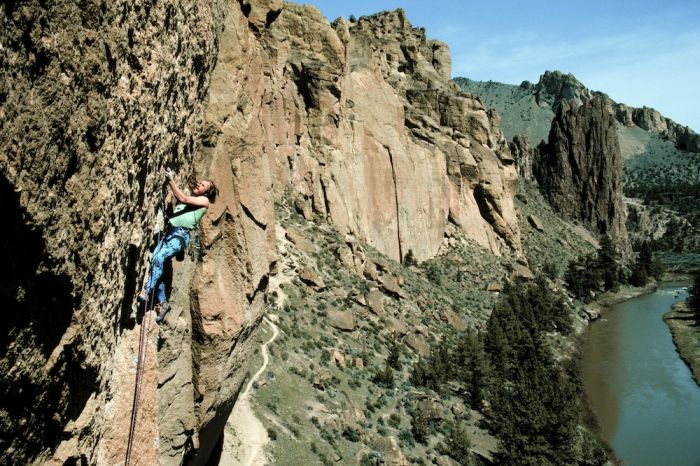
Scroll to the bottom for a glossary of terms and a gallery of action photos from Smith Rock throughout the years.
The Piton Pioneers
While there’s no record of prehistoric inhabitants and early settlers making ascents of its walls, Smith Rock’s first recorded climb in the area was made by Central Oregon resident Johnny Bissell in 1935. Others followed. In the mid-’40s, Portlanders Ross Petrie and Dave Pearson made some of Smith’s first difficult ascents.
But it wasn’t until the 1950s, when Jack Watts and brothers Jim and Jerry Ramsey, a trio from the nearby town of Madras, and Gil and Vivian Staender from Portland established climbing lines that brought national attention to this isolated area.
“My brother, Jerry, and Jack Watts had climbed some of the Cascade volcanoes, and the three of us got curious about rock climbing,” says Jim Ramsey, now 80. “It looked like a cool thing to do.”
At the same time, in Europe, climbing steep technical rock and ice routes in the Alps was gaining favor over traditional peak-bagging on easier terrain.
With hemp ropes, metal pitons and hammers to pound them into the rock—and using footwear ranging from hiking boots to sneakers—the Madras trio tramped off to Smith Rock with some ideas but little clue about what their exploration would bring. Mountaineering had been around as long as people and mountains have intersected, but climbing vertical and even overhanging slabs, was in its infancy. “It was very rare to see anyone else at Smith Rock, least of all climbers, and it was a huge deal if we found a piton in the rock,” Ramsey recalls. “Frankly, we climbed a lot of really rotten rock because we were so interested in getting to summits.”
Watts and the Ramsey brothers (together or with other partners) put up first ascents such as Asterisk, Platform, Arrowpoint, Cave Route on Brogan Spire, Diagonal Crack on Opposum, Inside Corner and East Chimney, among others. They gave many formations names such as Asterisk, Asterisk Pass and Brogan Spire—names that live on today. And while they didn’t leave anything behind to mark their summit ascents, the Staenders did.
In the late 1950s, husband and wife, Gil and Vivian Staender, made regular treks from their Portland home to climb in Smith Rock’s Pinnacles area. “In those days, we preferred to climb pinnacles and spires rather than big walls,” recalls Gil, now 82.
And climb they did, always leaving behind a summit register on one of their many routes. “I remember getting a call from Jim Ramsey after he found one of our registers, and we did a few climbs with him,” says Gil.
The Staenders made many courageous ascents, but the route most associated with their name in Smith Rock climbing history is the first successful ascent of Monkey Face on January 1, 1960.
Vivian Staender made the first ascent that cold January day with college students Jim Fraser and Dave Bohn, both of whom had only enough time to make the climb during their Christmas break from their studies at Oregon State University and the University of Oregon respectively.
“The boys bivouacked in the cave that forms the monkey’s mouth and were shivering by the time Viv climbed up to join them early the next morning,” Gil Staender says. “They made the summit push and all succeeded.” Vivian died in 1997.
In the spring of 2012, another relic of Smith’s first climbers surfaced. A Bend family on a hike in the Pinnacles area of Smith Rock stumbled onto an old yellow film canister. Opening it, they found a climbing register for Gunsight Rock dated September 21, 1958. Its first entry read: “Gil and Viv Staender ascended the main pinnacle by ladder. Then, one piton and up from the west.”
Today, the Staender name lives on at Smith Rock State Park in Staender Ridge, a group of pinnacles that include Adit Rock, Control Tower, Independence Tower, the Mole, Bette’s Needles, Flattop and Staender Summit.
The Dawn of Bouldering
About the time Ramsey free climbed the Awl, bouldering—climbing large free-standing boulders and rock outcrops, usually without ropes—was cropping up in Oregon. While already popular abroad, especially in Great Britain, this derivative sport was starting to gain acceptance among American climbers. Initially it was a way for timecrunched climbers to hone their skills without the need for protection, but it soon blossomed into a sport of its own.
Smith Rock found a bouldering champion in climber Chris Jones, who first arrived as a 15-year-old in 1973 and drove his parent’s Volkswagen van up Burma Road to climb at Staender Ridge.
Now a Bend resident, Jones recalls not getting truly interested in rock climbing and bouldering until Jim Ramsey and Alan Watts came to a class in the University of Oregon outdoor program when he was a freshman. From 1977 until 1979, Jones turned his attention to rock climbing and bouldering.
“The Smith Rock regulars found my concentration on bouldering a minor source of amusement,” Jones recalls. “But eventually all the free climbers came to embrace it.” Among Jones’ most memorable bouldering feats was “the Cave Problem” where he muscled through a steep overhang using, essentially, one arm and no feet.
As much as bouldering was gaining steam, something far more dramatic was about to take place in the sport, a change driven by yet another Madras local.
’60s and ’70s
In 1960, the State of Oregon created what is now the 650-acre Smith Rock State Park. The park became a reality because of its, “significant geological features,” and to “serve as a resource for public recreation.” Climbing wasn’t singled out, but a year later, the Staenders and Jim Ramsey threw open the doors to climbers in the new park by writing a ten-page guide to thirty climbing routes.
The focus of the guide and of Smith Rock’s early climbers was on attaining summits, and anything was fair game in getting to the top. The Staenders “ladder” attribution in the recently discovered summit register is evidence of this spirit. At this time, little or no attention was paid to free climbing—the use of climbing devices only to protect against a fall but not to help in the ascent.
In 1961, however, Jim Ramsey made the first free ascent of a formation called the Awl. Many believe that it was this climb that opened a new world to the free climbing possibilities at Smith Rock.
“I got part way up on my first attempt and realized the climb could go ‘free,’” Jim Ramsey recalls. “So I came back months later and did it. A decade later, someone informed me that the climb was rated 5.10c, which was two grades harder than anything I’d ever climbed.”
The Sporting Watts
Necessity was indeed the mother of invention in the case of piton pioneer Jack Watts’ son, Alan Watts.
Alan Watts’ first climb at Smith Rock was with a group of friends from Madras High School when he was 14. Ironically, while Watts and his father climbed together all over the Cascades until his early teens, the two never climbed together at Smith Rock.
“I basically taught myself how to rock climb and, by my late teens, had started to really focus on it,” Watts says. “But it wasn’t until I was in my early twenties that I started to get good at it, and it became my life.”
One day in 1982, Watts, then 21, got tired of climbing all of the established routes and decided to rappel down big walls to scout their potential. “I kept seeing all these amazing lines that looked like they wouldn’t go from the ground, but on rappelling down them, I’d see that they had plenty of good holds and were indeed climbable,” Watts recalls.
While rappelling down a potential route, Watts would drill bolts, into which he could clip protective devices on the ensuing ascent— a technique later referred to as “rap bolting.” It was a bold move for the Madras native who had been a traditional climber since childhood.
In contrast to traditional methods, where climbers place removeable protection pieces as well as fixed pitons, Watts tactfully drilled steel loops, or bolts, at intervals along harder climbs where traditional gear would not work. In doing so, Watts opened faces and routes that climbers previously considered beyond human capability. With partners such as Chris Grover (now an executive with climbing gear maker Black Diamond Equipment in Utah), Watts literally turned Smith Rock into his own private climbing area, controversy and all.
A 2010 Rock and Ice magazine feature entitled “10 Who Influenced” credits the younger Watts with inventing sport climbing. The story cited his February 1983 climb of the difficult 5.12-rated Chain Reaction route at Smith Rock State Park as the first sport climb of record.
Chain Reaction soon lived up to its calling. This route wasn’t known outside of Oregon until 1986, when it was featured on the cover of Mountain magazine, the most influential climbing magazine of the time.
As word about sport climbing spread, controversy swirled around Watts in the climbing magazines and among climbers.
To most climbers, sport climbing was akin to cheating—drilling into rock to affix permanent bolts in places that would normally be too dangerous to climb. At the time, American climbing community icon Royal Robbins disparaged sport climbing, saying it was as destructive to the rock as dirt motorcycle riding was to public lands.
Unfazed, Watts, then 25, headed to the Yosemite Valley to climb alongside some of rock climbing’s most adamant traditionalists. “I didn’t fear for my life while I was there, but I was scared that my car might get trashed,” Watts says of the time spent in Yosemite’s Camp Four, where he was considered a heretic.
While in the Yosemite Valley, he temporarily suspended his bolt placement sport climbing technique. “I’d hang on a rope viewing a route from top to bottom and then come back later and climb it from the ground up without any falls,” he says. “The Yosemite climbers were against my concept at first, but soon some were giving me credit for climbing the hard routes they couldn’t master by traditional techniques.”
Prior to going to Yosemite in ’85, Watts had made the first free ascent (placing protection as he climbed) of the east side of Monkey Face, a route that would long hold the distinction as the hardest route in the country.
Continuing to push the boundaries of climbing, Watts, by more traditional means, began to work on a route called “To Bolt or Not To Be.” Rated an extremely difficult 5.14, this route superseded all others as the most difficult rock climb in the U.S. at the time.
In 1986, French climber J.B. Tribout arrived at Smith to witness climbing’s new playground. In one push, he flashed up Watt’s project, To Bolt or Not To Be. Publicity of this climb sparked worldwide interest in sport climbing and made Smith Rock famous beyond American borders. Suddenly Smith Rock was a kaleidoscope of climbers in brightly colored Lycra tights and muscle shirts pushing the limits on tough sport climbs. On a typical day in the ’80s, it wasn’t unusual to hear a dozen foreign languages echoing between Smith Rock’s big and bolted walls.
The 90’s and Now
In the ’90s, things changed. “There was a definite lull in the rock climbing scene, and Smith fell off the circuit as climbers started to go to other areas that got more publicity and weren’t as far off the beaten path,” notes Greg Garretson, 34. He started climbing at Smith Rock as a 14-year-old, ditching high school classes in Bend to further his budding climbing career.
In 1995, journeyman climber Tim Toula published his comprehensive guide itemizing all of the best places to climb across the country. With this bible in hand, climbers fanned out from Smith, landing in places such as Red Rock in Las Vegas, Red River Gorge in Kentucky, New River Gorge in West Virginia and Colorado’s Rifle Canyon.
Slowly, though—over the past five to six years—Garretson and others have witnessed a rebirth at Smith Rock. “People are really psyched to be at Smith again, and many of the classic lines that had been forgotten are getting new attention,” says Garretson. The climbing scene, as he is quick to point out, is less about the publicity of flashing new routes in neon spandex. “Best of all the adventure is back,” he asserts.
What began with a rappel, a drill and heresy has today become mainstream for novice to competitive climbers.
Vanessa Burdick, a 23-year-old competitive climber from Georgia, arrived in Central Oregon a year-and-a-half ago to attend school at Oregon State University’s Cascades campus. “The fact that Smith Rock was so close motivated my choice to go to OSU-Cascades,” she says.
The growth of the local college campus has helped draw younger climbers to the area, but so has the weather. Finding a crag that was good to climb year-round was one of the reasons Cristina Rose Mastrangelo, 30, moved to Bend from Vermont eighteen months ago. She is drawn to the variety of routes, many of which are technique-intensive. “The challenging climbing here only makes you better,” she says.
As Burdick and Mastrangelo enhance the current climbing community, a new generation ascends Smith Rock’s hard surfaces. Once recognized as one of the world’s most daring alpine climbers, John Bouchard now teaches school in Redmond and climbs at Smith Rock with his wife, Nancy, and their three young girls.
“Of all the areas I’ve climbed, Smith Rock is one of the most family friendly,” Bouchard assesses. “The routes are accessible via short, easy hikes. There are plenty of one-pitch climbs that are low angle enough that they are not intimidating, even for toddlers.”
Glossary terms:
Piton: A flat or angled metal blade of steel which incorporates a clipping hole for a carabiner or a ring in its body. A piton is typically used in “aid-climbing,” and an appropriate size and shape is hammered into a thin crack in the rock and preferably removed by the last team member.
Sport climbing: Sport climbing is a style of rock climbing that relies on permanent anchors fixed to the rock, especially bolts, for protection.
Free climbing: A type of rock climbing in which the climber uses only hands, feet and other parts of the body to ascend, employing ropes and forms of climbing protection to prevent falls only.
Bouldering: A style of rock climbing undertaken without a rope and normally limited to very short climbs over a crash pad (called a bouldering mat) so that a fall will not result in serious injury. It is typically practiced on large natural boulders or artificial boulders in gyms and outdoor urban areas.
Trad climbing: A style of rock climbing in which a climber or group of climbers places all gear required to protect against falls (pitons, etc.), and removes it when a passage is complete.
A Sample of Smith Rock Climbs
Compiled by Alan Watts, author of Rock Climbing Smith Rock State Park, the guide book.
Round River 5.4
Five Gallon Buckets 5.7
Super Slab 5.7
Wartley’s Revenge 5.11a
Monkey Space 5.11b
Toxic 5.11b
Chain Reaction 5.12c
Churning in the Wake 5.13a
To Bolt or Not to Be 5.14a
Camping Smith Rock
Skull Hollow
The campground is 7.9 miles to the east from the main parking area at Smith Rock State Park. It’s open March 1 through November 30. There are thirty campsites with parking pullouts and two pit toilets. Water is not available. Other services are minimal so please take your trash with you
Smith Rock Bivouac Area
The campground at Smith Rock State Park is a walkin campground and is open year-round. Overnight camping in vehicles is not allowed. Space is available on a first-come basis and reservations are not accepted. Fees are $5 per person per night, which includes the $5 parking permit for the following day and use of the showers. Showers are available for $2 to people not registered in the campground. The restrooms and showers are located next to the campground parking lot. Campsites are located 150 feet from the parking area. Fires are not allowed, and a leash is required for pets.
Visit smithrock.com for more information on things to do in and around Smith Rock State Park.
Other Climbing Areas Around Oregon
Broughton Bluff | Troutdale
Wallowa Mountains | Northeast Oregon
Skinner Butte Columns | Eugene
Bandon Needles | Oregon Coast
Illumination Rock | Mt. Hood area
Source: Rock ‘n Road: Rock Climbing Areas of North America


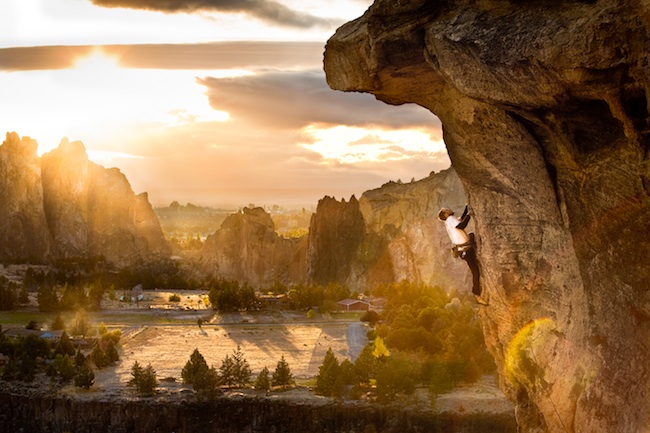
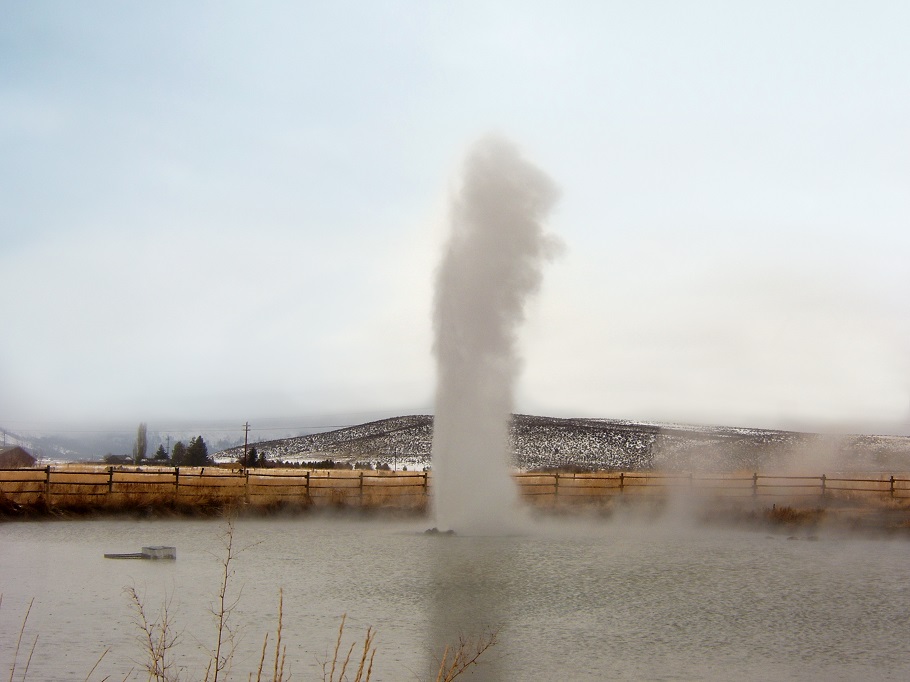

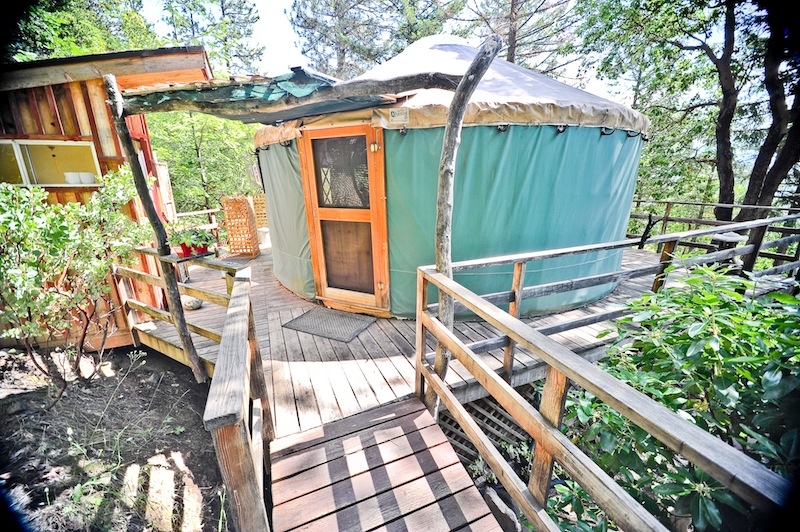
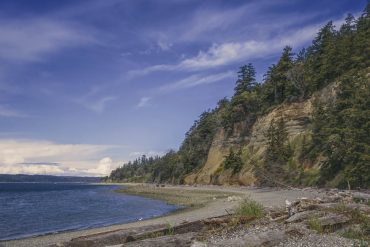



Can I ask who was the author of this article?